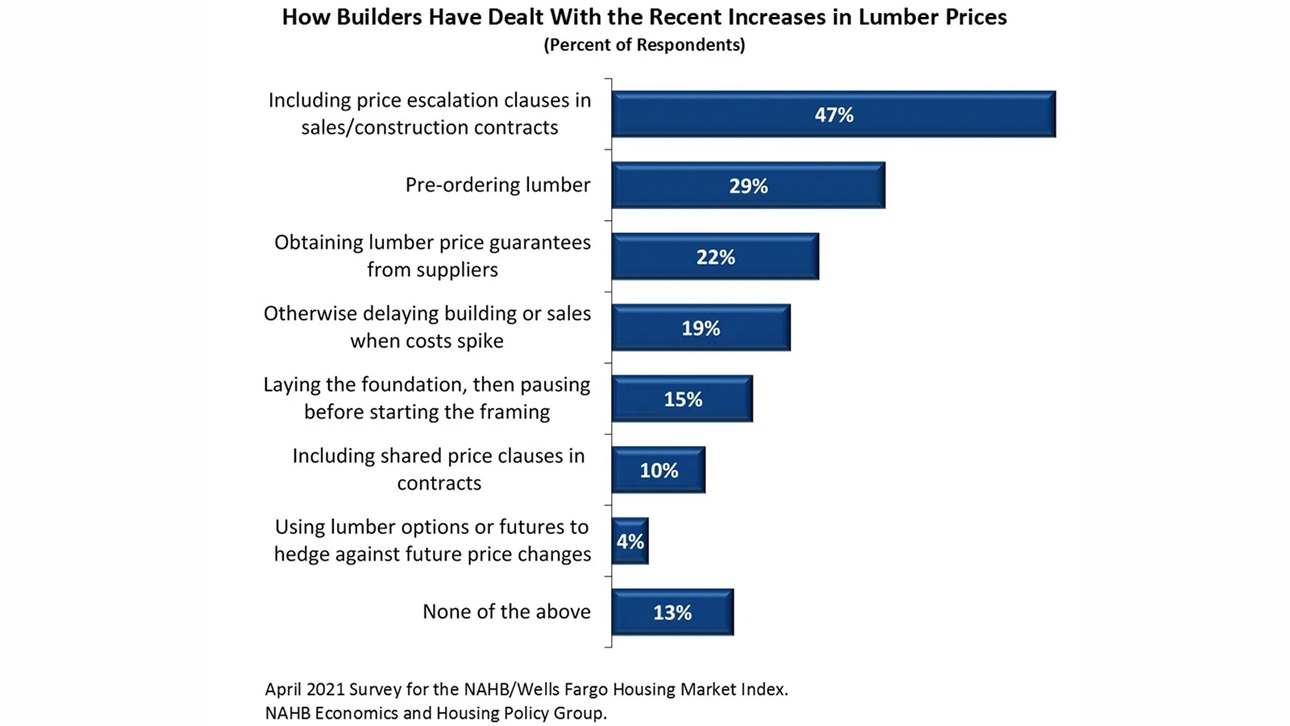How Builders Are Dealing with Rising Lumber Prices
As NAHB continues to work tirelessly to combat rising lumber prices and supply shortages by aggressively engaging with the Biden administration and members of Congress, builders who are on the frontlines are engaging in several strategies to mitigate this unprecedented price surge that is raising housing costs and impacting their bottom lines.
NAHB recently asked builders about their reactions to the rising and volatile lumber prices in its April 2021 survey for the NAHB/Wells Fargo Housing Market Index (HMI). Nearly half (47%) of single-family builders in the HMI panel indicated that they were including price escalation clauses in their sales contracts as their primary mitigation effort.
“It’s been a difficult time for us and home owners,” Jeremy Burke, a remodeler in Pennsylvania, shared through NAHB’s online lumber testimonial form. “We have had to prepare contracts with clauses for material change orders when materials cost rise — which I fear means we will lose contacts and/or projects for those who can’t afford the extra costs.”
Other efforts include pre-ordering lumber (29%) and obtaining lumber price guarantees from suppliers (22%). According to responses, prices were typically guaranteed for 15-29 days (42% of respondents reported) or 30-59 days (33% of respondents reported), for a median length of 28 days.
“We are pricing each unit on a case-by-case basis, and only after we have a commitment on actual lumber costs for that unit,” noted Thomas Troy, a builder in New Jersey, in a testimonial. “We are at the point where we are withholding new sections in some projects.”
Nearly one in five builders (19%) have also, unfortunately, had to delay building or sales when costs spike, and 15% indicated they are laying the foundation but pausing before framing. This puts further strain on the much-needed housing supply necessary to help make housing affordable.
“We have always prided ourselves on being able to provide affordable housing to our local market, while also being financially prudent to the best practices in the building industry,” stated Michael Welty, a builder in Colorado, in a testimonial. “When you couple these price increases with the limited amount of supply that currently resides in our housing market, the current conditions are creating an escalating market that in our opinion will eventually be unsustainable.”
Paul Emrath, vice president of surveys and housing policy research, provides more analysis and details in this Eye on Housing post.

Latest from NAHBNow
Jan 09, 2026
From Décor to Resiliency, IBS Design Central Covers It AllAt the 2026 NAHB International Builders’ Show® (IBS) in Orlando Fla., there will be education sessions centered on design. Design Central will offer engaging presentations led by some of the industry’s top professionals, covering everything from décor to sustainability. Here are the Design Central presentations, all taking place at the Orange County Convention Center (OCCC).
Jan 09, 2026
Final Touches Underway at The New American Home 2026Watching a new home come to life in the final stages of construction is a satisfying experience—not just for the owners, but for the builder as well. That feeling is only amplified when the home is a focal point of the International Builders’ Show (IBS)—the industry’s largest trade show.
Latest Economic News
Jan 09, 2026
Townhouse Construction Share Gains ContinueAccording to NAHB analysis of the most recent Census data of Starts and Completions by Purpose and Design, during the third quarter of 2025, single-family attached starts totaled 46,000. Over the last four quarters, townhouse construction starts totaled a strong 179,000 homes, which is 1% higher than the prior four-quarter period (177,000). Townhouses made almost 20% all of single-family housing starts for the third quarter of the year.
Jan 09, 2026
Job Growth Slowed as 2025 EndedJob growth continued to slow at the end of the year, reinforcing signs of a cooling labor market. Nonfarm payrolls increased by 50,000 jobs in December, while the unemployment rate edged down slightly to 4.4%.
Jan 09, 2026
Residential Construction Softens Amid Ongoing Housing Market HeadwindsThe latest residential housing market report, delayed by the federal government shutdown last fall, indicates that builders have faced significant headwinds in recent months. Elevated mortgage rates earlier in the year have restrained buyer demand and weighed on home building activity, alongside persistently high construction costs.
